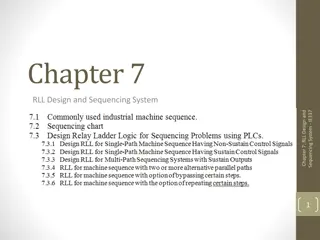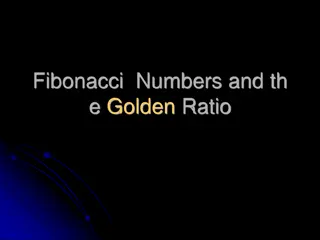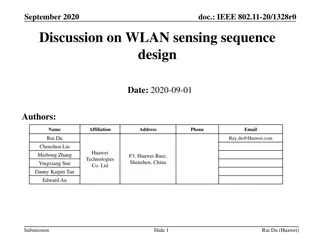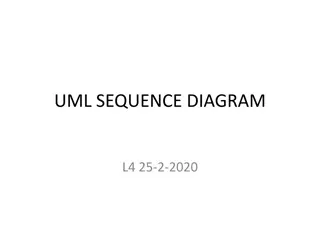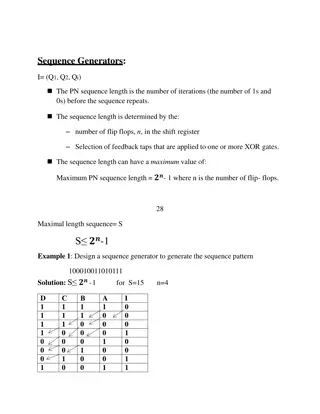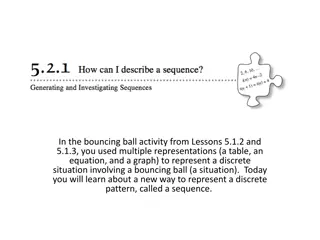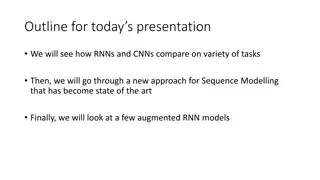
String Data Types and Operations in Python
Explore the world of strings in Python, from defining string data types to manipulating them using various operations such as accessing, modifying, and utilizing built-in string methods. Learn how to work with sequences, characters, escape characters, and more.
Download Presentation

Please find below an Image/Link to download the presentation.
The content on the website is provided AS IS for your information and personal use only. It may not be sold, licensed, or shared on other websites without obtaining consent from the author. If you encounter any issues during the download, it is possible that the publisher has removed the file from their server.
You are allowed to download the files provided on this website for personal or commercial use, subject to the condition that they are used lawfully. All files are the property of their respective owners.
The content on the website is provided AS IS for your information and personal use only. It may not be sold, licensed, or shared on other websites without obtaining consent from the author.
E N D
Presentation Transcript
Strings String is a subtype of the sequence data type Written with either single or double quote Note: there is no character data type in Python. A character is a string with one character. s1 = "This is a string!" s2 = Python is so awesome.
Accessing a String Strings can be accessed element-wise as they are technically just sequences of character elements. String elements can be indexed with typical bracket notation and range of characters slicing s1 = "This is a string!" s2 = Python is so awesome. print(s1[3]) # output: s print(s2[5:15]) # output: n is so awesome
Modifying a String Strings are immutable you cannot update the value of an existing string object. However, you can reassign your variable name to a new string object to perform an update . s1 Python is so awesome. s1 = "Python is so awesome." print(s1) s1 = "Python is so cool." print(s1) s1 Python is so awesome. Python is so cool.
Modifying a String Alternatively: s1 = "Python is so awesome." print(s1) s1 = s1[:13]+"cool." print(s1) creates a substring Python is so , which is concatenated with cool. , stored in memory and associated with the name s1. + operator concatenates two strings * operator concatenates multiple copies of a single string object. in and not in test character membership within a string.
Escape Characters most common: \n newline \s space \t tab
Built-in String Methods Note that these return the modified string value; we cannot change the string s value in place because they re immutable! s.upper() and s.lower() s1 = "Python is so awesome." print(s1.upper()) print(s1.lower())
Built-in String Methods s.isalpha(), s.isdigit(), s.isalnum(), s.isspace() return True if string s is composed of alphabetic characters, digits, either alphabetic and/or digits, and entirely whitespace characters, respectively. s.islower(), s.isupper() return True if string s is all lowercase and all uppercase, respectively. print("WHOA".isupper()) print("12345".isdigit()) print(" \n ".isspace()) print("hello!".isalpha())
Build-in String Methods str.split([sep [,maxsplit]]) Split str into a list of substrings. sep argument indicates the delimiting string (defaults to consecutive whitespace). maxsplit argument indicates the maximum number of splits to be done (default is -1). str.rsplit([sep [,maxsplit]]) Split str into a list of substrings, starting from the right. str.strip([chars]) Return a copy of the string str with leading and trailing characters removed. chars string specifies the set of characters to remove (default is whitespace). str.rstrip([chars]) Return a copy of the string str with only trailing characters removed. print("Python programming is fun!".split()) print("555-867-5309".split('-')) print("***Python programming is fun***".strip('*'))
Built-in String Methods str.capitalize() o returns a copy of the string with the first character capitalized and the rest lowercase. str.center(width [,fillchar]) o centers the contents of the string str in field-size width, padded by fillchar (defaults to a blank space). See also str.ljust() and str.rjust(). str.count(sub [,start[, end]]) o return the number of non-overlapping occurrences of substring sub in the range [start, end]. Can use slice notation here. str.endswith(suffix[, start[, end]]) o return True if the string str ends with suffix, otherwise return False. o Optionally, specify a substring to test. See also str.startswith(). print("i LoVe pYtHoN".capitalize()) print("centered".center(20,'*')) print("mississippi".count("iss")) print("mississippi".count("iss", 4, -1)) print("mississippi".endswith("ssi")) print("mississippi".endswith("ssi", 0, 8))
Built-in String Methods str.find(sub [,start[, o return the lowest index in the string where substring sub is found, such that sub is contained in the slice str[start:end]. o Return -1 if sub is not found. o See also str.rfind(). str.index(sub [,start[, end]]) end]]) o identical to find(), but raises a ValueError exception when substring sub is not found. o See also str.rindex(). str.join(iterable) o return a string that is the result of concatenating all of the elements of iterable. o The str object here is the delimiter between the concatenated elements. str.replace(old, new[, count]) o return a copy of the string str where all instances of the substring old are replaced by the string new (up to count number of times).
Built-in String Methods print("whenever".find("never")) print("whenever".find("what")) print("whenever".index("never")) print("whenever".index("what")) print("-".join(['555','867','5309'])) print(" ".join(['Python', 'is', 'awesome'])) print("whenever".replace("ever", "ce"))
String formatting There are several ways for string format. The preferred way is to use f- strings. o By putting an f in front of a string literal, we create an f-string. Example: t = f This is an f-string. print(t) An f-string can have placeholders { }, which can contain expressions (variables, functions) and modifiers to format the value: val = 500 t = f This is an f-string. val = {val} print(t)
Placeholders in f-string t = f val = {500} print(t) v = 500 t = f v*2 = {v * 2} print(t) price = 59 taxRate = 0.075 t = f Total price is {price + price * taxRate} . print(t) a = apple b = grape t = f I like {a.upper() + ORANGE } and {b.upper()}. print(t) A placeholder can contain any expressions including constants and functions. An f-string can have any number of placeholders.
Modifier We can further format the values in the in the placement holder with modifier o Modifier starts with a : and only takes some fixed format. o Placeholder with modifier has the form of {expression modifier} See the list of modifiers at https://www.w3schools.com/python/python_string_formatting.asp Exercise: Print the header of the ps command. print( f val = {1000000000:,} ) # comma as thousand separator print( f val = {12.342344:.3f} ) # float point number with a 3 decimals print(f { Hello :>30} ) # Right align to 30 letter space print(f { 100 :^10} ) # center of 10 digits
String format() Old form of string formatting The signature is: str.format(*args, **kwargs)) *args argument indicates that format accepts a variable number of positional arguments, **kwargs indicates that format accepts a variable number of keyword arguments. str can contain literal text or replacement fields, which are enclosed by braces {}. Each replacement field contains either the numeric index of a positional argument, or the name of a keyword argument. A copy of the string is returned where each replacement field is replaced with the string value of the corresponding argument.
String formatting examples print('{0}{1}{2}'.format('a','b','c')) print('{}{}{}'.format('a','b','c')) print('{2}{1}{0}'.format('a','b','c')) print('{2}{1}{0}'.format(*'abc')) print('{0}{1}{0}'.format('abra', 'cad')) print('Coords: {lat}, {long}'.format(lat='37.24N', long='-115.81W')) coord = {'lat': '37.24N', 'long': '-115.81W'} print('Coords: {lat}, {long}'.format(**coord))
Lists When to use lists? o When you need a collection of elements of varying type. o When you need the ability to order your elements. o When you need the ability to modify or add to the collection. o When you don't require elements to be indexed by a custom value. o When you need a stack or a queue. o When your elements are not necessarily unique.
Creating Lists To create a list in Python, we can use bracket notation to either create an empty list or an initialized list. mylist1 mylist2 mylist3 =[]#Createsanemptylist =[expression1,expression2,...] =[expressionforvariableinsequence] The first two are referred to as list displays, where the last example is a list comprehension.
Creating Lists We can also use the built-in list constructor to create a new list. =list() #Createsanemptylist =list(sequence) = list(expression for variable in sequence) mylist1 mylist2 mylist3 The sequence argument in the second example can be any kind of sequence object or iterable. If another list is passed in, this will create a copy of the argument list.
Creating Lists Note that you cannot create a new list through assignment. o Assignment creates an alias, but not the new list object. # mylist1 and mylist2 point to the same list mylist1 = mylist2 = [] # mylist3 mylist3 mylist4 and mylist4 mylist3=[] mylist4=mylist3 mylist5 = []; mylist6 = [] # different lists
Accessing list elements If the index of the desired element is known, you can simply use bracket notation to index into the list. If the index is not known, use the index() method to find the first index of an item. An exception will be raised if the item cannot be found. mylist = [34,67,45,29] print(mylist[2]) mylist = [34,67,45,29] print(mylist.index(67))
Slicing The length of the list is accessible through len(mylist). Slicing is an extended version of the indexing operator and can be used to grab sublists. mylist[start:end] #itemsfromstarttoend-1 mylist[start:] #itemsfromstarttoendof thearray mylist[:end] #itemsfrombeginningtoend-1 mylist[:] #acopyofthewholearray You may also provide a step argument with any of the slicing constructions above. mylist[start:end:step] # items fromstartto end-1,incremented by step
Slicing The start or end arguments may be negative numbers, indicating a count from the end of the array rather than the beginning. This applies to the indexing operator. mylist[-1] #last element in the list Mylist[-2:] #the last two itemsof thearray mylist[:-2] #all except the last two items Examples: mylist = [34, 56, 29, 73, 19, 62] print(mylist[-2]) print(mylist[-4::2])
Inserting Elements To add an element to an existing list, use the append() method. Use the extend() method to add all of the items from another list mylist = [34, 56, 29, 73, 19, 62] mylist.append(47) print(mylist) mylist = [34, 56, 29, 73, 19, 62] mylist.extend([47,81]) print(mylist)
Inserting/Removing Elements Use the insert(pos, item) method to insert an item at the given position. You may also use negative indexing to indicate the position. Use the remove() method to remove the first occurrence of a given item. An exception will be raised if there is no matching item in the list. mylist = [34, 56, 29, 73, 19, 62] mylist.insert(2,47) print(mylist) mylist = [34, 56, 29, 73, 19, 62] mylist.remove(29) print(mylist)
List as a Stack You can use lists as a quick stack data structure. The append() and pop() methods implement a LIFO structure. The pop(index) method will remove and return the item at the specified index. If no index is specified, the last item is popped from the list. stack = [34, 56, 29, 73, 19, 62] stack.append(47) print(stack) stack.pop() print(stack)
List as a Queue Lists can be used as queues natively since insert() and pop() both support indexing. However, while appending and popping from a list are fast, inserting and popping from the beginning of the list are slow. from collections import deque queue = deque([35, 19, 67]) print(queue) queue.append(42) queue.append(23) print(queue) print(queue.popleft()) print(queue) print(queue.popleft()) print(queue) Use the special deque object from the collections module.
Some other useful operations The count(x)method will give you the number of occurrences of item x within the list. The sort()and reverse()methods sort and reverse the list in place. The sorted(mylist)and reversed(mylist) built-in functions will return a sorted and reversed copy of the list, respectively. mylist = ['a', 'b', 'c', 'd', 'a', 'f', 'c'] print(mylist.count('a')) mylist = [5, 2, 3, 4, 1] mylist.sort() print(mylist) mylist.reverse() print(mylist)
Custom Sort Both the sorted() built-in function and the sort() method of lists accept some optional arguments. sorted(iterable[,cmp[,key[,reverse]]]) The cmp argument specifies a custom comparison function of two arguments which should return a negative, zero or positive number depending on whether the first argument is considered smaller than, equal to, or larger than the second argument. The default value is None. The key argument specifies a function of one argument that is used to extract a comparison key from each list element. The default value is None. The reverse argument is a Boolean value. If set to True, then the list elements are sorted as if each comparison were reversed.
Custom Sort mylist = ['b', 'A', 'D', 'c'] mylist.sort(key = str.lower) print(mylist)
Set When to use set? o When the elements must be unique. o When you need to be able to modify or add to the collection. o When you need support for mathematical set operations. o When you don't need to store nested lists, sets, or dictionaries as elements.
Creating Set Create an empty set with the set constructor. myset =set() myset2 =set([])#bothareemptysets Create an initialized set with the set constructor or the { } notation. Do not use empty curly braces to create an empty set you ll get an empty dictionary instead. myset =set(sequence) myset2 ={expressionforvariableinsequence}
Hashable Items The way a set detects non-unique elements is by indexing the data in memory, creating a hash for each element. This means that all elements in a set must be hashable. All of Python s immutable built-in objects are hashable, while no mutable containers (such as lists or dictionaries) are. Objects which are instances of user-defined classes are also hashable by default.
Mutable operations set|=other Update the set, adding elements from all others. |... s1 = set('abracadabra') s2 = set('alacazam') print(s1) print(s2) s1 |= s2 print(s1) s1 = set('abracadabra') s1 &= s2 print(s1) set&=other Update the set, keeping only elements found in it and all others. &... set-=other Update the set, removing elements found in others. |... set^=other Update the set, keeping only elements found in either set, but not in both.
Set Operations The following operations are available for both set and frozenset types. Comparison operators >=, <= test whether a set is a superset or subset, respectively, of some other set. The > and < operators check for proper supersets/subsets. s1 = set('abracadabra') s2 = set('bard') print(s1 >= s2) print(s1 > s2) print(s1 <= s2)
Set Operations Union: Return a new set with elements from the set and all others. set | other | s1 = set('abracadabra') print(s1) s2 = set('alacazam') print(s2) print(s1|s2) print(s1&s2) print(s1-s2) print(s1^s2) Intersection: Return a new set with elements common to the set and all others. set & other & Difference: Return a new set with elements in the set that are not in the others. set other Symmetric Difference: Return a new set with elements in either the set or other but not both. set^other
Tuples When to use tuples? o When storing elements that will not need to be changed. o When performance is a concern. o When you want to store your data in logical immutable pairs, triples, etc.
Creating Tuples With an empty set of parentheses Pass a sequence type object into the tuple() constructor. t1 = (1, 2, 3, 4) t2 = "a","b","c","d" t3 = () t4 = ("red", ) print(t1) print(t2) print(t3) print(t4) By listing comma-separated values. Note: These do not need to be in parentheses but they can be. One quirk: to initialize a tuple with a single value, use a trailing comma.
Tuple Operations Similar to lists and support a lot of the same operations. Accessing elements: use bracket notation (e.g. t1[2]) and slicing. Use len(t1) to obtain the length of a tuple. The universal immutable sequence type operations are all supported by tuples. +, * o o in, not in o min(t), max(t), t.index(x), t.count(x)
Packing/Unpacking packing packs a collection of items into a tuple unpack a tuple via Python s multiple assignment feature s = "Susan", 19, "CS" # tuple packing print(s) name, age, major = s # tuple unpacking print(name) print(age) print(major)
Dict When to use dictionaries? o When you need to create associations in the form of key:value pairs. When you need fast lookup for your data, based on a custom key. o When you need to modify or add to your key:value pairs. o
Creating a Dictionary Create an empty dictionary with empty curly braces or the dict() constructor. You can initialize a dictionary by specifying each key:value pair within the curly braces. Note that keys must be hashable objects. #constructing a dictionary d1 = {} d2 = dict() # both empty d3 = {"Nme": "Susan", "Age": 19, "Major": "CS"} d4 = dict(Name="Susan", Age=19, Major="CS") d5 =dict(zip(['Name', 'Age', 'Major'], ["Susan", 19, "CS"])) d6 = dict([('Age', 19), ('Name', "Susan"), ('Major', "CS")]) Note: zip takes two equal-length collections and merges their corresponding elements into tuples.
Accessing the Dictionary To access a dictionary, simply index the dictionary by the key to obtain the value. An exception will be raised if the key is not in the dictionary d1 = {'Age':19, 'Name':"Susan", 'Major':"CS"} print(d1['Age']) print(d1['Name'])
Updating the Dictionary Simply assign a key:value pair to modify it or add a new pair. The del keyword can be used to delete a single key:value pair or the whole dictionary. The clear() method will clear the contents of the dictionary. d1 = {'Age':19, 'Name':"Susan", 'Major':"CS"} d1['Age'] = 21 d1['Year'] = "Junior" print(d1) del d1['Major'] print(d1) d1.clear() print(d1)
Some built-in Dictionary methods d1={'Age':19, 'Name':"Susan", 'Major':"CS"} print(d1.__contains__('Age')) # True if key exists print(d1.__contains__('Year')) # False otherwise print(d1.keys()) # Return a list of keys print(d1.items()) # Return a list of key:value pairs print(d1.values()) # Returns a list of values print(d1.pop('Age')) print(d1) print(d1.popitem()) print(d1) print('Major' in d1) print('Name' in d1) print('Major' not in d1) print('Name' not in d1) Note: in, notin, pop(key),and popitem()are also supported.
Ordered Dictionary Dictionaries do not remember the order in which keys were inserted. An ordered dictionary implementation is available in the collections module. The methods of a regular dictionary are all supported by the OrderedDict class. An additional method supported by OrderedDict is the following: OrderedDict.popitem(last=True) #pops itemsinLIFO order
Ordered Dictionary # regular unsorted dictionary import collections d = {'banana': 3, 'apple': 4, 'pear': 1, 'orange': 2} # dictionary sorted by key d2 = OrderedDict(sorted(d.items(), key=lambda t: t[0])) print(d2) # dictionary sorted by value d3 = OrderedDict(sorted(d.items(), key=lambda t: t[1])) print(d3) # dictionary sorted by length of the key string d4 = OrderedDict(sorted(d.items(), key=lambda t: len(t[0]))) print(d4)
Ordered Dictionary with custom comparison function # custom_comparison.py import collections Import functools d = {'banana': 3, 'apple': 4, 'pear': 1, 'orange': 2, kiwi : 10} def comp(a, b): if (len(a[0]) > len(b[0]): return 1 elif len(a[0]) < len(b[0]): return -1 else : if (a[1] > b[1]): return 1 else: return -1 # dictionary sorted by key d2 = collections.OrderedDict(sorted(d.items(), key=functools.cmp_to_key(comp))) print(d2)
File Operations: open/close A file must be open before other operations o file_object = open(file_name [, access_mode][, buffering]) o Access mode: r for read, w for write, r+ for read and write, etc. o Buffering usually use default #lect4/open.py fobj = open( open.py , r+ ) print(f Filename: {fobj.name} ) print(f Access mode: {fobj.mode} ) print(f Closed? {fobj.closed} ) fobj.close() print(f Filename: {fobj.name} ) print(f Access mode: {fobj.mode} ) print(f Closed? {fobj.closed} ) A file object has several objects such as name, closed, mode Opened file should be closed. o close() flushes buffered info and close the file object no more write can be done. o Without close(), file may not be in the final state.

